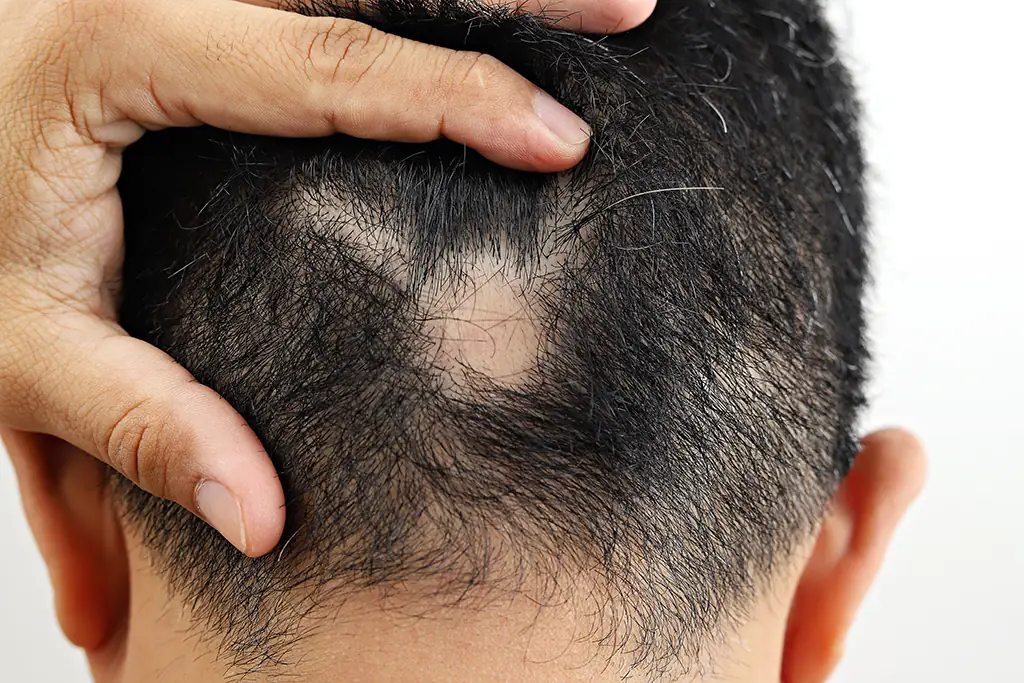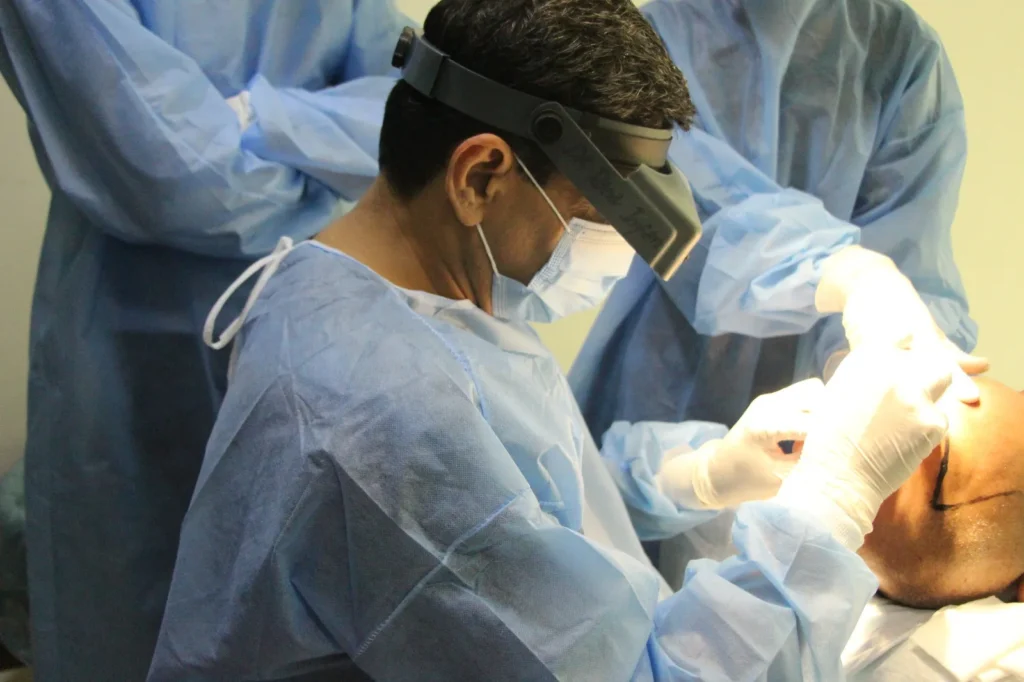Hair thinning can feel overwhelming, especially when traditional treatments don’t seem to help. That’s where PRF for hair loss comes in, offering a natural and regenerative solution using your body’s healing cells.
In this article, you’ll discover how PRF works, how it’s different from PRP, and whether it’s the right choice for your stage of hair loss. With expert insights, real results, and a treatment breakdown, this guide will help you make an informed, confident decision.
What Is PRF for Hair Loss?

Definition: Platelet-Rich Fibrin (PRF) Explained
PRF stands for Platelet-Rich Fibrin, a next-generation regenerative treatment derived from your blood. It’s packed with growth factors, white blood cells, and stem cells that help repair tissues and stimulate hair regrowth.
Unlike traditional medications, PRF takes advantage of your body’s natural healing potential, without chemicals or synthetic substances.
How It Differs from PRP (Platelet-Rich Plasma)
PRF and PRP both use blood-derived platelets, but they differ in concentration and efficacy:
- PRF is spun at a lower speed, preserving more healing cells.
- It forms a fibrin matrix, which allows for slower, sustained release of growth factors.
- PRF doesn’t use anticoagulants, making it 100% natural.
In short, PRF is considered more advanced and longer-acting than PRP.
How PRF Is Derived from Your Blood
Here’s how the process works:
- A small amount of blood is drawn from your arm.
- It’s spun in a low-speed centrifuge to separate the fibrin-rich portion.
- The PRF is immediately used to inject into thinning areas of the scalp.
How PRF Works to Regrow Hair
Growth Factors and Their Role in Hair Follicles
The healing components in PRF include:
- PDGF (Platelet-Derived Growth Factor)
- TGF-β (Transforming Growth Factor Beta)
- VEGF (Vascular Endothelial Growth Factor)
These growth factors:
- Stimulate angiogenesis (new blood vessel formation)
- Reactivate dormant hair follicles
- Improve cellular turnover and collagen production
The Natural Healing and Regeneration Process
After injection, PRF promotes cell migration and tissue repair at the follicle level. This encourages:
- New hair growth
- Thicker, healthier strands
- Reduced shedding over time
Stimulating Dormant Follicles and Boosting Density
Patients often notice increased hair density, especially in areas of diffuse thinning. While it may not regrow hair in completely bald areas, it strengthens weak follicles and helps preserve existing hair.
Who Is a Good Candidate for PRF Hair Treatment?
Early-Stage Hair Loss Patients
PRF is most effective for individuals experiencing:
- Mild to moderate hair thinning
- Androgenetic alopecia (male or female pattern baldness)
- Increased shedding with visible scalp

Post-Transplant Density Improvement
PRF is often used after hair transplant surgery to:
- Accelerate healing
- Improve graft survival
- Stimulate growth in surrounding native follicles
Men and Women with Androgenetic Alopecia
Both genders can benefit from PRF, especially if they want:
- A non-surgical solution
- To delay the need for transplant
- To maintain results from medication like minoxidil or finasteride
PRF Hair Loss Treatment Procedure: What to Expect
Pre-Treatment Preparation
- Avoid alcohol and anti-inflammatory medications 48 hours before
- Eat a light meal before your session
- Drink plenty of water
Blood Draw and Centrifugation
- About 10–15 ml of blood is collected
- Spun for 5–8 minutes at a low speed
- PRF is extracted immediately for injection
Injection Process and Duration
- PRF is injected into the scalp using a fine needle or microneedling device
- The procedure takes about 45–60 minutes
- Minimal discomfort; numbing cream may be applied
Pain Level and Comfort Considerations
- Most patients report only mild pressure or tingling
- There’s no downtime, and you can return to normal activity the same day
PRF for Hair Loss Results: Before and After
Timeline of Visible Results
| Timeframe | What to Expect |
|---|---|
| Week 1–2 | Reduced shedding |
| Month 2–3 | Noticeable thickening |
| Month 4–6 | New baby hairs and increased density |
| Month 6+ | Full visible results |
PRF vs PRP: Which Is Better for Hair Loss?
Key Differences in Composition
| Feature | PRF | PRP |
|---|---|---|
| Platelet count | Higher | Moderate |
| Growth factor release | Slow, sustained | Rapid, short-lived |
| Anticoagulants | None (100% natural) | Yes |
| Stem cells | Present | Minimal |
Effectiveness Based on Scientific Evidence
While both treatments show benefits, PRF has shown more consistent long-term results in recent studies due to its improved cell composition.
Cost, Frequency, and Convenience Comparison
- PRP: Cheaper per session, but may require more sessions
- PRF: Slightly more expensive, but fewer sessions needed due to efficacy
Safety, Side Effects, and Recovery After PRF
Is PRF Safe? What Studies Say
Because PRF is made from your blood, there’s minimal risk of allergic reactions or complications. It’s widely used in:
- Orthopedics
- Dental surgery
- Cosmetic procedures
Common Side Effects to Know
- Mild swelling or redness
- Temporary tenderness at injection sites
- Rarely, bruising or headache
Post-Treatment Care and Recovery Tips
- Avoid washing your scalp for 12 hours
- No intense workouts for 24 hours
- Don’t apply topical treatments for 48 hours
How Many PRF Sessions Are Needed for Hair Regrowth?
Typical Treatment Plan (3–6 Sessions)
- Most patients require 3–4 monthly sessions
- Maintenance every 6–12 months is recommended
Maintenance and Long-Term Results
Patients can maintain results for 12–18 months with proper scalp care, diet, and supplements. Many combine PRF with topical or oral treatments.
Cost of PRF for Hair Loss in Pakistan (and Globally)
Average Cost per Session
- Pakistan: PKR 15,000–30,000 per session
- USA/UK: $400–$900 per session
What Influences the Price?
- Clinic reputation and location
- Technology and centrifuge quality
- Practitioner experience
Is It Covered by Insurance?
No—PRF is considered aesthetic and elective, so it’s not typically covered by insurance.
PRF Use in Combination with FUE or Medications
- After FUE Hair Transplant: Boosts graft survival
- With Minoxidil or Finasteride: Enhances results
- As a stand-alone, it works best in the early-stage loss

FAQs About PRF Hair Loss Treatment
Is PRF FDA-approved for hair loss?
PRF is not FDA-approved specifically for hair loss, but it is used off-label by licensed practitioners with growing clinical support.
How long does it take to see hair regrowth?
You’ll typically start noticing changes in 2–3 months, with fuller results by 6 months.
Can PRF replace hair transplant surgery?
For mild to moderate hair loss, yes. But for advanced baldness, a hair transplant may still be necessary.
How does it feel during and after the procedure?
Most describe it as mildly uncomfortable, with some tightness or swelling for 1–2 days.
Final Thoughts: Is PRF Worth It for Hair Loss?
Who Will Benefit the Most?
PRF is ideal if you:
- Want a natural, non-surgical approach
- Are you noticing early thinning or shedding
- Need to enhance hair transplant results
When to Consider Other Options
If you have:
- Extensive bald areas
- Scarring alopecia
- Unrealistic expectations from non-surgical treatments
Take Your Next Step
Ready to try a natural solution for thinning hair?
Book a personalized hair restoration consultation with Dr. Rana Irfan in Islamabad, an ABHRS-certified expert with over 20 years of experience.
Take the first step toward thicker, healthier hair—schedule your consultation today.
